|
VORONYA 2009
Darko Bakšić
In the period from October 23 to November 18, 2009, Robert Erhard and
Darko Bakšić, members of the Velebit Speleological Section, the
Speleological Committee of Croatian Mountaineering Association and the
Croatian Mountain Rescue Service, took part in an expedition into
Voronya, the deepest known cave in the world (-2,191 m).
The expedition was organized by an international speleological CaveX
team led by Denis Provalov and Oleg Klimchouk. The goal of the
expedition was to enlarge one side passage at a depth of -1,980 m in
order to bypass the Kvitochka siphon, which would allow easier transport
of diving and other equipment to the Dva Kapitana siphon. Exploration
will continue in the course of 2010.
A fifteen-member team from Russia, Ukraine, Hungary and Croatia set
up a base camp, lowered several hundreds kilograms of equipment to the
depth of -1,980 m and continued with enlarging the mentioned passage. A
summer expedition had already worked for 8 days to widen the passage
while work at this expedition lasted for 6 days. There are still 2 to 3
days of work left before the whole passage is widened and uninterrupted
transport of equipment is made possible. Work is planned to continue at
the end of January or August 2010, which depends on weather conditions
and financial means.
During the expedition Robert Erhardt and Darko Bakšić made a lot of
photographic and film material, passed the 2,000 m mark and descended
into the Game Over chamber, situated at -2,080 m.
|
Members of the expedition
|
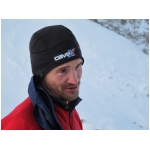
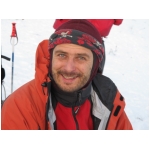
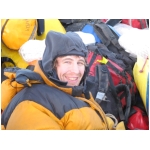
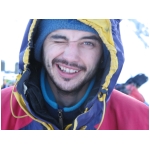
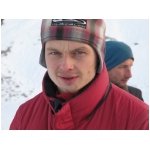
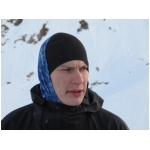
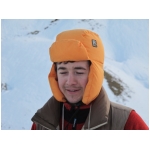
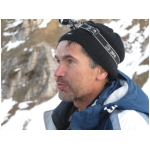 |
Denis Provalov
(Russia, Moscow)
Oleg Klimčuk
(Ukraine, Kiev)
Jurij Bazilevskij
(Russia, Chelyabinsk)
- joined the expedition
on October 31, 2009
Dimitrij Fedotov
(Ukraine, Poltava)
Dimitrij Vikorčuk
(Russia,
Yekaterinburg)
Vasilij Hohrin
(Russia, Samara)
Mihail Rafikov
(Russia,
Yekaterinburg)
Andrej Rjanskij
(Russia, Moscow)
- arrived
31.10.2009.
|
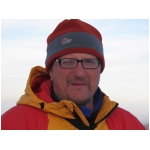
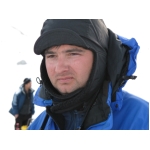
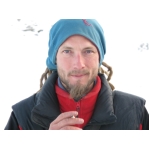
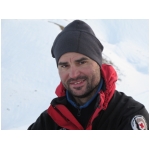
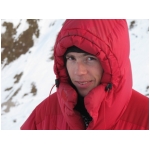
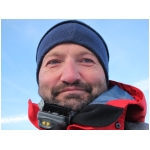
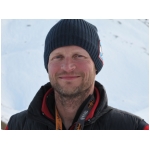
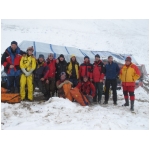 |
Valerij Akulenko
(Russia, Mezdurechensk)
Vlad Troc
(Russia, Moscow)
Peter Kunisch
(Hungary, Budapest)
Attila Nyerges
(Hungary, Budapest)
Denes Pataki
(Hungary, Budapest)
Robert Erhardt
(Croatia, Zagreb)
Darko Bakšić
(Croatia, Zagreb)
Expedition photography |
|
More on the Voronya
exploration can be found at
Voronya plan
CaveX
Support of Croatian members:



Thanks to
Croatian Mountain Rescue Service - station Zagreb |
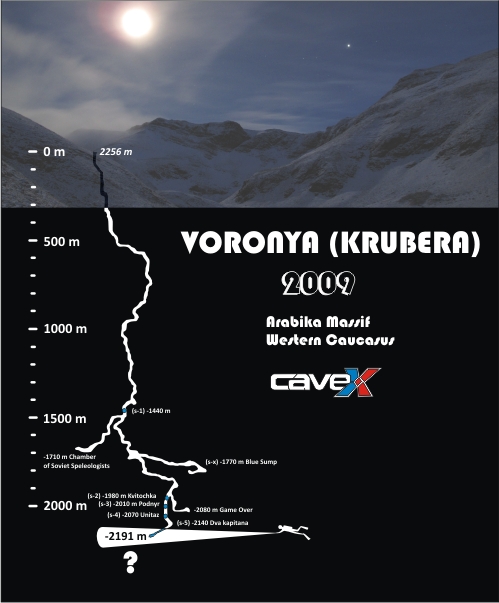
MORPHOLOGICAL DESCRIPTION OF A PART OF THE
VORONYA CAVE FROM THE ENTRANCE TO THE GAME OVER CHAMBER
The entrance vertical shaft is 57
m deep. Passing through a narrow meander, with three shorter drops,
you enter a 115 m deep vertical shaft. The vertical shaft ends with
a chamber. Then another squeeze through a narrow meander and you are
in a 43 m vertical shaft. Two ropes have been set up in the upper
third of the shaft. One leads to the Meander Krym and downwards to
the bottom of Voronya, and the other into a part called the
Nekujbyshevskaja branch. The Meander Krym leads to a vertical shaft
of 110 m. Double ropes have also been set up in the shaft, which
join into a traverse after some 40 m. From here, one rope leads
to the Mozambique meander. This meander has the characteristic
keyhole shape. The meander ends with the most spacious and the
largest vertical pit of 152 m. The bottom of the pit ends in a
chamber at -500 m, which used to be a camp. From here, you enter the
Sinusoida meander. This meander is characterized by distinct
meandering both in the vertical and horizontal direction. You
generally walk along the bottom of the meander, where there is also
water current. The meander also reveals traces of walking at an
elevated level, which is done when water is high. There are several
shorter pits of 8 m, 19 m and 26 m. At one point, the meander is
joined by another meander called Lamprechtsofen. The name reflects
the fact that this meander was climbed from -570 m and -359 m. The
Sinusoida meander ends with spacious vertical shafts of 22 m and 71
m (the Petit Dru). The bottom of the Petit Dru shaft is at -700 m.
This is where the first camp has been established. It can
accommodate 3 to 4 persons. Water is immediately behind the camp.
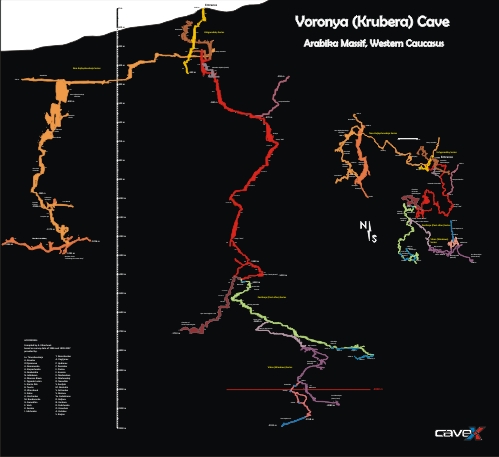
There are much larger quantities of water between
-700 m and -1,100 m. Each vertical shaft is a waterfall; therefore,
this part of the cave abounds in anchors, traverses and deviators.
In August, when expeditions are usually organized, the underground
contains much more water, so this part of the cave must look
spectacular. The order of the vertical pits from the camp at -700 m
to the camp at – 1,215 m has been taken from the plan and is as
follows: 24 m, 45 m, 43 m, 40 m, 40 m, 49 m, 40 m, 28 m, 33 m and 71
m, while that of the camp at -1,215 m to the Sandy Beach camp is 22
m, 21 m, 21 m, 10 m, 29 m and 23 m. The camp at -1,215 m is on the
edge of a spacious chamber and is no longer used. It continues to
the bivouac at -1,410 m. Just before the bivouac there is a vertical
shaft that passes very close to the waterfall. To prevent water
drops spraying the speleologists, a canvass has been stretched for
the purpose of diverting the water flow. The bivouac at -1,410 m is
the most spacious. It is made of the construction and folios and can
house 10 to 12 speleologists. The water is not immediately next to
the camp, so in order to reach it you go through a boulder chock and
descend into the meander. The water is filled into an impermeable
sack, a part of the transport bag, and carried to the bivouac.
At the Sandy Beach camp there are hydrocostumes – waterproof dry
suits with an opening on the belly through which you enter the suit.
The suit is then closed with a piece of rubber (similar like
“banana” rubber for carry unused carabide made from a car tire inner
tube). After the cavers put on the dry suits at the Sandy Beach camp,
they descend towards the first siphon. To reach the siphon, you must
pass a short meander and then a series of vertical pits of 17 m and
12 m. The siphon is at -1,440 m. In the winter period, when the
water is shallower, you breathe dive the siphon. The siphon is 3 m
long and between 1 and 0.5 m deep. In summer time, the length of the
siphon is about 6 m, so you dive it by using small tanks. All the
gear is transported through the siphon in the following manner: the
transport bags are sunk and pulled by rope. The siphon is followed
by two more vertical pits: “Second Life” of 35 m and “Everest” of 12
m. This is where the dry suits are taken off. Very shortly you reach
a meander featuring the narrowest part of the cave; luckily, however,
it is not too long. You pass through the “Shining Meander”. This is
a magnificent meander containing abundant flowing water. To descend
from the “Everest” pit to the KSS bivouac at -1,640 m you must pass
a series of vertical pits of 15 m, 25 m, 15 m, 18 m, 30 m, 5 m and
18 m. The KSS camp can accommodate 6 speleologists. It is situated
in a point where the cave diverges: one part leads to the Blue Sump,
and the other to the bottom. In the immediate vicinity of the camp
there is water, which you reach by climbing through a small passage
in the rock and continuing downwards. This passage can easily be
overlooked, since it is more logical to continue along the passage
towards the Blue Sump. A small passage at the KSS
camp is the point at which crawling starts. This is followed by
short jumps. Between -1,640 m and -1,700 m you arrive in a part
called “The Way to the Dream”. Lying in very shallow water, you craw
sideways for the next 60 or so metres. The dimensions of the passage
increase again. The cave descends elbow-like, revealing beautiful
potholes and speleothems. The walls are dark, calcareous,
sporadically laced with white marl veins. The Peremička bivouac is
at -1,970 m. This bivouac, accommodating 4 speleologists, is
situated exactly in the middle of the passage in the Rebus part. In
order to reach the part of the cave called “Game Over”, you must
literally go through the camp. Two more vertical shafts follow, of
which the bigger of 40 m is called the Millennium, because it is at
this point that you pass the magical depth mark of -2,000 m. From
-2,060 m to -2,080 m you pass some 100 m along a low passage whose
walls are covered with clay. A shaft of 20 m ends in a chamber
called Game Over at a depth of -2,080 m. Traces in the cave indicate
that water levels rise from -2,080 m to – 1,960 m. Just before the
Peremička camp, a passage diverges towards the Kvitochka sump. Two
more siphons, Podnir (-2,010 m) and Unitaz (-2,070 m) and you reach
the Dva Kapitana sump at -2,140 m. The sump descends to the point at
which the highest depth of the Voronya Cave of -2,191 m has been
reached so far.
DIARY OF THE EXPEDITION
October 23, 2009, Friday
We arrive at Pleso Airport around 12 a.m. Robi and myself have 40 kg
of equipment each. We charm the ladies at the check-in desk and promise
that we will pretend that our 18 kilograms of hand luggage is light. We
will carry it with a brave smile. We take off at 14.10.
The flight to Moscow was comfortable. We land at about 7 p.m. The flight
takes 3 hours, but the time difference is +2 hours.
We leave the luggage in a guarded area of Sheremetyevo Airport and buy
train tickets to the "Belarus vagzal" station, where we arrive after a
35-minute ride. We wait for a short time for Denis Provalov and a girl
called Julia, at whose place we are to sleep over. Julia is a
22-year-old sociology student. She is cheerful and hospitable.
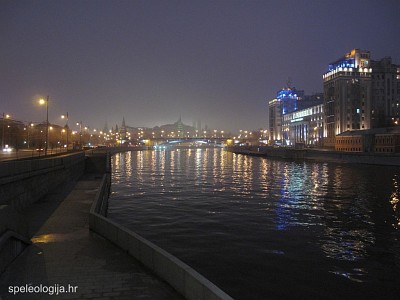
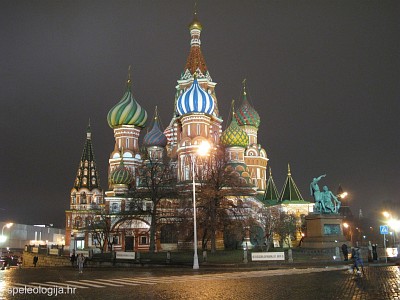
Moscow. Photo: D.Bakšić
Denis is 40, very nice and slightly rushed. He has the constitution
of a runner. He tells us that Moscow has changed dramatically in the
last 15 years. There is a lot of construction going on, many green areas
have disappeared, and the influx of the population has been enormous.
The population of Moscow is currently estimated at over 20 million. We
again drive to the other end of the town to Julia's apartment. Her
family moved to Moscow from the Baikal area several years ago. She lives
with her sister Katja, while her parents live and work outside Moscow.
The building is nicely decorated, and so is the apartment. There are an
innumerable number of doors to be locked. Both sisters have already been
to Voronya: Julia at -700 m and Katja at -1,440 m. Katja is a more
ardent speleologist and she goes on speleological expeditions two to
three times a year.
October 24, 2009, Saturday
Julia leaves for the faculty, while we have breakfast and wait for
Denis. Julia's mother arrives at about 11 a.m. and is surprised to find
the two of us in the apartment. It was a close shave; if it had been
Julia's father, a general, we would probably have had to jump down from
the 15th floor. Denis and his wife Zenja (Eugenia) pick us up and we all
go to the airport. Denis flies with us. We take off from Moscow for
Sochi at 14.10. The temperature of 23 °C in Sochi is a very pleasant
surprise. We were picked up by Vasya, a customs officer who lives in
Sochi, in a part called Adler. Denis tells us that Vasya has a beautiful
daughter Olya of 20 years of age, who is a heart-throb of numerous
speleologists that come to Arabika. After dinner, Vasya takes us to the
border, which we pass very quickly. Then we cross the Psou River on foot
by the bridge. We carry all our stuff. At the border with Abkhazia Denis
help us with permits and visas. We finally cross over into Abkhazia and
rent a taxi to the first inn, where the first part of the team is
waiting for us. After getting to know each other and eating dinner we
leave for the house which has for years been the main base for
speleological expeditions on Arabica. We sit around with our new friends
from Russia, some of whom have arrived from as far as the Urals and
Siberia.
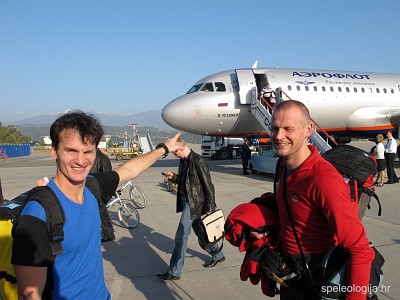
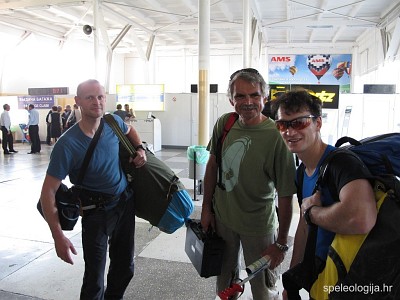
Adler - Provalov shows in the direction of
Arabika. We were picked up by Vasja Maskov. Photo: R.Erhardt
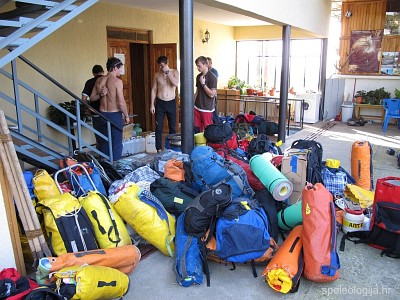 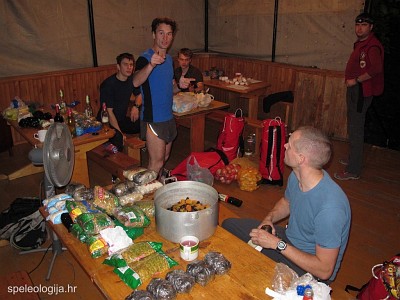
Gentiady.
Packing the food for the cave. Photo: R.Erhardt
October 25, 2009, Sunday
At abut 2 a.m. I was woken by our roommate Vlad, who was snoring like a
Siberian bear. I pull out my sleeping bag and blanket from the rucksack
and go to sleep in the yard. Despite the snoring, Robi sleeps the sleep
of the righteous. I don't understand how he manages it, until I see him
in the morning pulling the earplugs out of his ears. My sleeping bag is
too warm, so I can hardly wait for the morning.
In the morning Denis goes to pick up Klim (Oleg Klimchouk) and the rest
of the Ukraine team. One part of the team goes to Sochi to get some
food, Robi and I go to the beach. We were not particularly impressed by
the beach. Just a long sandy – pebbly stretch. The place we are in is
called Gentiady (another name is Candripsh). It is rather untidy and
neglected. Upon arrival, Provalov and Klim make an exploration plan for
Voronya, while we pack carbide into rubber hoses. We later join them at
the beach and swim in the Black Sea.
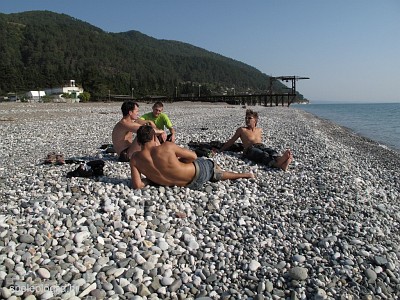 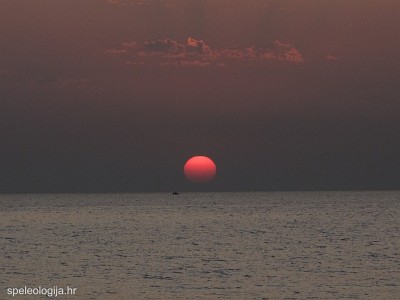
Black Sea. Photo: D.Bakšić
When we are all gathered, we start packing the food for the cave.
Everything is planned meticulously and in detail. All the food has been
divided by meals and by bivouacs, taking into account the number of the
people staying in them. We give 500 Euros each to cover the expedition
costs.
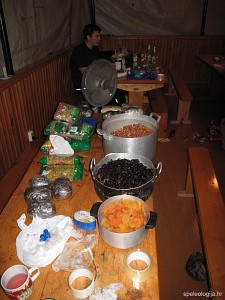
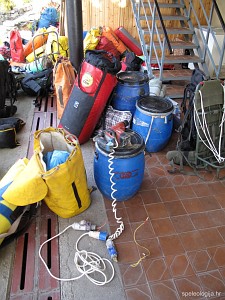
Packing the food and other equipment for the cave Photo: D.Bakšić
Late lunch consists of borsch. Just as we in Velebit club do, we all
wait while the food is being prepared, gather around and eat together. I
was pleasantly surprised by the fact that alcohol is consumed in minimal
quantities, just one beer or a glass of wine. By 10 p.m. everybody is in
bed.
October 26, 2009, Monday
Valery gets up very early, at about 5 a.m. I hear him making a racket
around the dining room above the terrace I am sleeping on. I feel the
wind on my face and think the weather will be changing. I get up at 7
with the first sun rays. A cheerful Valery offers coffee in the dining
room and tells me that in Siberia, his homeland, it is already noon, and
this is why he wakes up so early. The rest get up an hour later. Klim
and Provalov go for a run and Vlad drinks tea. That night Robi, too, was
kept awake by his snoring. Not even the earplugs could help.
Vlad loves telecommunications devices. In his belt bag he has radio
stations, mobile phones and a satellite phone stacked together.
Provalov is a PE teacher. He is currently taking part in a project which
tests the health condition and preparedness of people under extreme
conditions, so he explains that he will make the measurements before,
during and after the expedition.
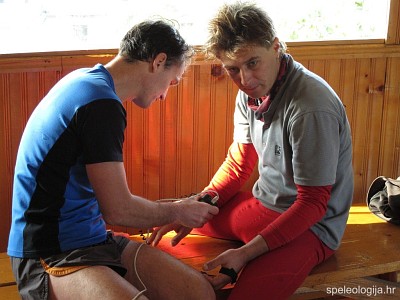 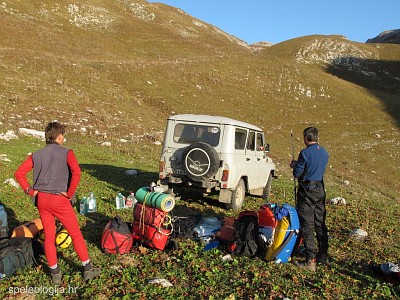
First measurement.
Arrival on Arabika. Photo: R.Erhardt
We rent an UAZ all-terrain vehicle, and together with Klim and Vlad
leave for the cave one day before. The two-and-a-half hour ride is more
like gymnastics because we have to move the bodies to compensate for the
dangerous keeling of the vehicle. The beech-fir forest belt on so-called
Arabika Gate is followed by the alpine zone.
There is an hour's walk from the end of what is left of the road to the
camp. The camp is situated about 2,200 m asl and it is rather cold. We
set up the kitchen and the tents and go to fetch two more rounds of the
gear.
October 27, 2009, Tuesday
One more morning round of fetching the things, and a part of the stuff
we need is in the camp. Robi and I have a peek into the nearby “Ž 13
cave” and find there a mount of the stuff left over from previous
expeditions. The cave serves as a storage place and a shelter.
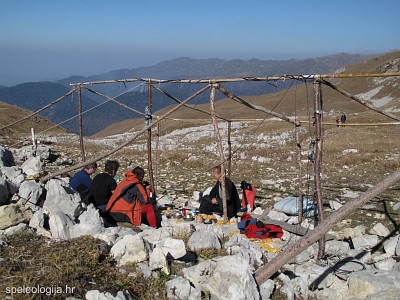 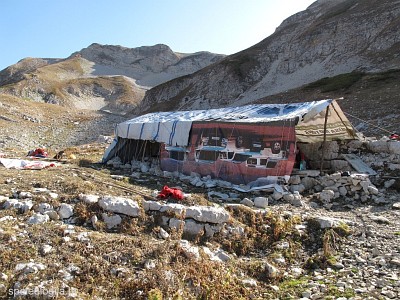
We pull up a large base canvas. Photo: D.Bakšić
We pull up a large base canvas across the existing wooden
construction set up by the summer expedition.
The rest of the team arrives on a truck at about 15.30. We help them
unload and transport the equipment.
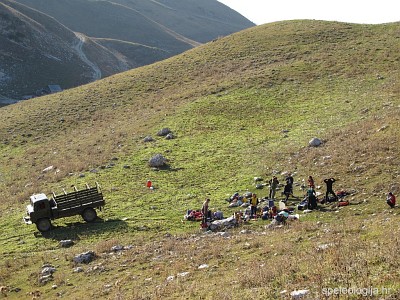 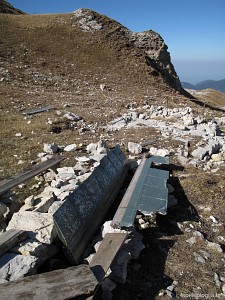
Arrival of the rest of speleologists. Photo: R.Erhardt
Helicopter remains. Photo: D.Bakšić
We are finally all gathered together. The Hungarian speleologists,
who had missed the train and thus arrived a day later, are also here.
Two more rounds of bringing the equipment to the camp. After that we sit
around in the base camp drinking tea and eating, and go to bed early, at
9 p.m.
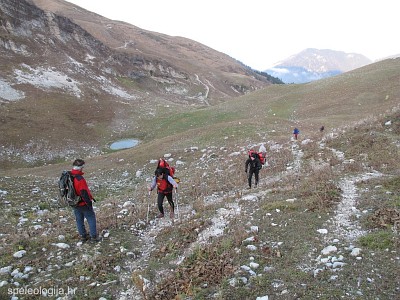 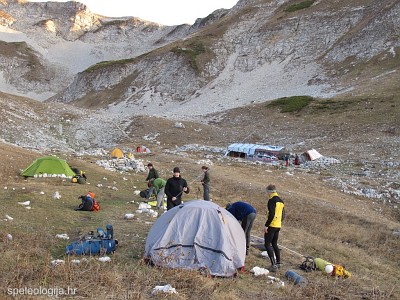
Bringing the equipment to the camp. Photo: D.Bakšić.
Base camp. Photo: R.Erhardt
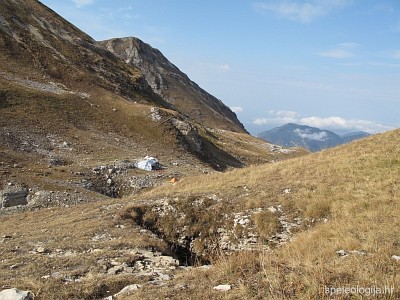 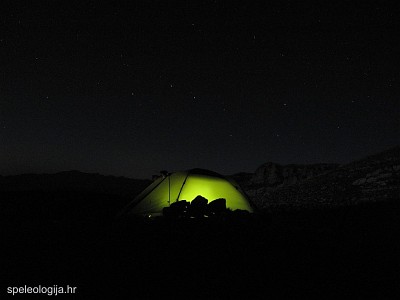
The first entrance to Voronya. Photo: R.Erhardt.
The first night in base camp. Photo: D.Bakšić
October 28, 2009, Wednesday
Morning workout consists of fetching the things. For me, this is the
sixth round.
The entrance to Voronya Cave is about 150 meters from the camp, at an
altitude of 2,256 m.
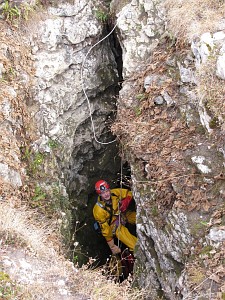
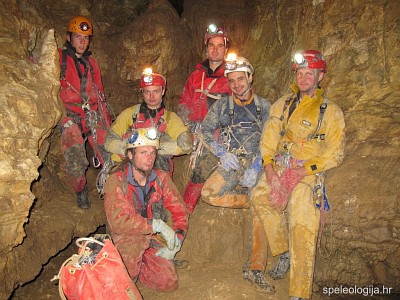
The first entrance to Voronya. Meander Krym.
Photo: R.Erhardt
We begin entering Voronya at about 13.30. The first to go in are Misha
and Vasya, who check the ropes and the anchors and repair things that
need repairing. All the others carry a heavy transport bag each to the
Meander Krym at -240 m, while we also take photos. On the way back Robi
and myself remain the last in order to take photographs, but we soon
give it up, because the evaporation from our PVC caving suit makes
everything misty. When we get out at about 19.00, we are hit by rain and
wind.
We have dinner, charge the batteries, transfere the photographs on
laptop and make plans for tomorrow.
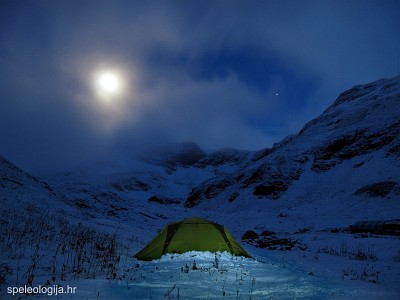 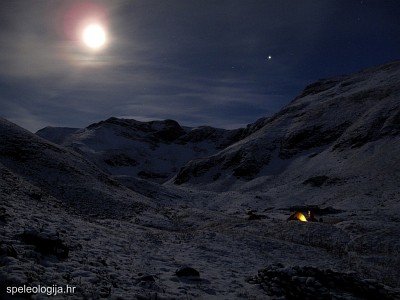
. Photo: D.Bakšić
October 29, 2009, Thursday
It was pouring with rain the whole night, there was lightning and
thunder, and before morning the rain turned into show.
Provalov, Klim, Misha, Kajo, Attila and Denis enter Voronya about 10
o'clock. They descent to -700 m and establish a bivouac.
The rest of us clear the snow from the tent and go to fetch some more
equipment to the camp.
The cave team comes out at about 8 p.m. They have done everything,
except that the phone does not function. We prepare iron rods for
grounding since the telephone uses only one wire.
The sky clears up, and the moonlit night is very beautiful.
October 30, 2009, Friday
Waking up, making plans and finally, about 1 p.m., Provalov, Misha, then
Dima, Dima and Vasily go into Voronya. Each of them carries a transport
bag from the entrance to the Meander Krym. They each take three more
bags at the Krym Meander, which they leave in front of the Meander
Sinusoida at a depth of -500 m.
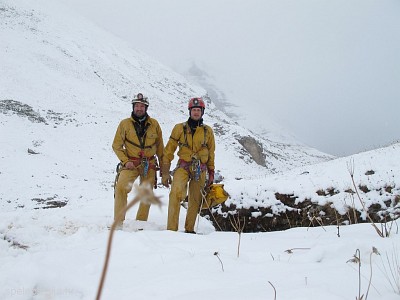
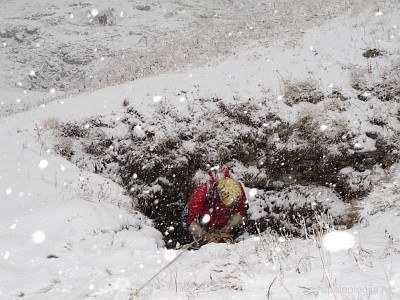
Robi and Bakša at the entrance. Photo: Provalov
The second entrance in Voronya - descending to -700 m - first snow.
Photo: R.Erhardt
Robi and I enter after them. From the entrance we carry two bags
each, plus a camera, lamps and some additional clothing. This hinders us
considerably in the meanders. We take pictures on the way.
After descending to the bivouac at -700 m, Provalov goes out. Misha,
Dima, Dima and Vasya continue towards the Sandy Beach bivouac at -1,410
m, while Robi and I go back to get three more transport bags left in
front of the Meander Sinusoida at -500 m. About 22.30 we again come to
the bivouac at -700 m. We cook and at the same time dry ourselves on
petroleum stoves after trying to put them into operation, which almost
ended up by burning the bivouac to the ground.
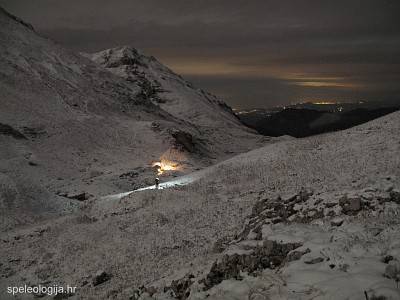
After descending to the bivouac at -700 m, caver is coming out of a cave.
Photo: D.Bakšić
October 31, 2009, Saturday
We cooked pasta and "granny's porridge", drank a lot of tea and received
instructions from the base camp on the surface.
We must get back from the bivouac at -700 m to the Meander Krym at -240
in order to fetch two transport bags and lower them to the Sandy Beach
bivouac at -1,410 m. The Hungarians lower the transport bags from the
surface to -1,410 m, while the rest of the team, which is already at
-1,410 m, climbs up to get the transport bags left at -700 m. "General
migration" across the cave.
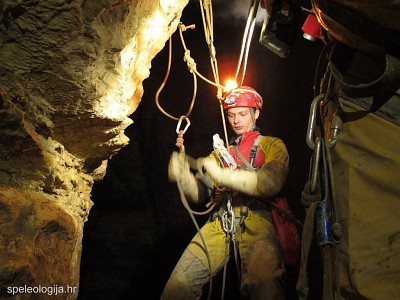
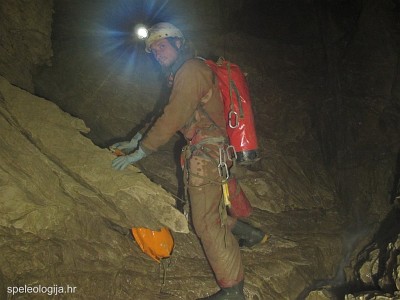
Below the Krym Meander at about -300 m.
At -800 m. Photo: R.Erhardt
We meet the Hungarians a little below the Krym Meander at about -300
m. All together, we carry the transport bags to -700 m, where we find
the team which has just arrived from -1,410 m. We rest for a short
while, make tea and then we all set off towards the Sandy Beach bivouac.
The Hungarians and we make pictures along the way. The frequent pulling
out of the camera, accompanied by constant shifting and carrying of the
two heavy transport bags is a complicated maneuver that tires me
considerably. Not only me, but also the rest of the team, because I keep
stopping them. Luckily, they show understanding and patience.
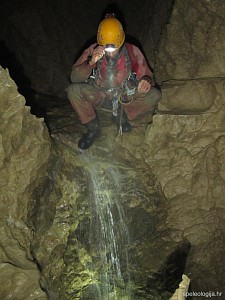
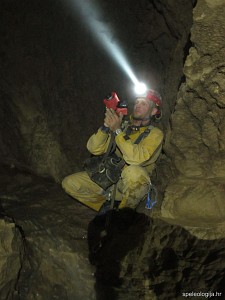
Making a movie. Photo: R.Erhardt
I can take a lot of pictures with personal light because they all
have Scurions. I'm not very happy, but taking pictures in such a
situation is not the priority, so we must satisfy ourselves with only
fleeting photography. We reach the Sandy Beach bivouac after midnight.
It's Vasya's birthday, so we celebrate with a gulp of cognac and
Hungarian vin pelin Unicum. We go to sleep very late, at about 4 a.m.
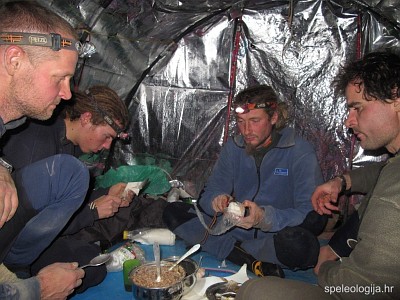
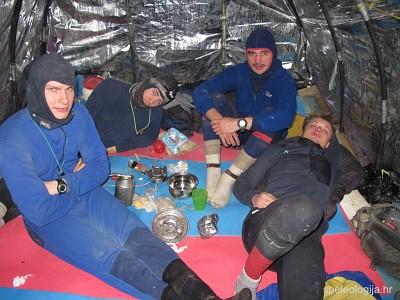
Sandy Beach bivouac at -1410 m. Photo: R.Erhardt
November 1, 2009, Sunday
We get up at about 8. We did not really have much sleep. Robi and I join
Misha, Dima, Dima and Vasya. The plan is for us to go through the first
siphon at -1,440 m, while the Hungarians go back to -700 m.
We slowly get ready. I had to replace the sheave on the new stop
descender since it got completely worn out during the descent of only
2,000 m. The combination of stiff 9 mm Ukrainian ropes and mud on them
visibly wears the devices out. Luckily, the Hungarians had several spare
sheaves and devices.
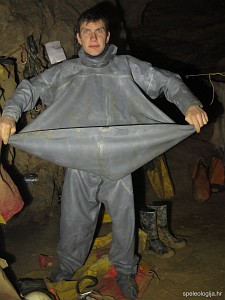 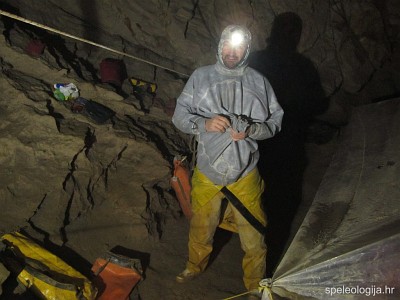
Water-proof dry suits (hydrocostumes). Photo: R.Erhardt
Robi in hydrocostume. Photo: D.Bakšić
Breakfast, tea and long preparations for putting on the water-proof
dry suits (hydrocostumes) - under the PVC or cordura caving suits, so it
is already 14.00 when we finally leave for the siphon. We carry two
transport bags each. A short meander and then a descent to the siphon at
-1,440 m. At this time of the year it is only three meters long and
about 1 meter deep. We breathe dive the siphon by pulling ourselves
along the rope. You scrape the rock with your back. The diver's mask is
not used because you don't see anything anyway. The two Dimas, who
already feel at home here, take care that we all get through the siphon
safely. In the end we pull the 12 transport bags through the siphon and
descend by one vertical shaft, where we take off our water-proof
hydrocostumes. As we are taking them off, we notice that three of us
have switched boots. We all wear the same size, and the boots look the
same, so no wonder this has happened. There is a squeeze shortly
afterwards, where we must take off the gear in order to pull through.
Robi passes this place "at a breath".
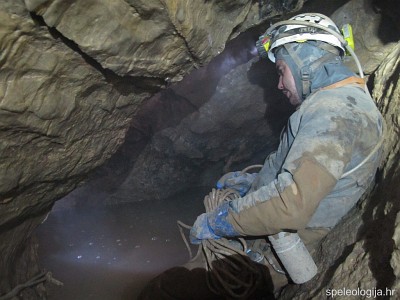
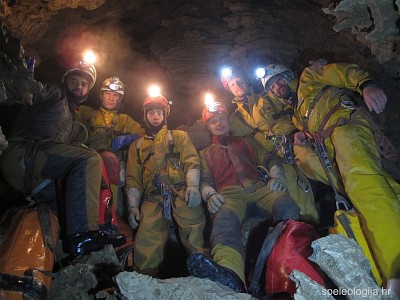
Dima close to S1 at -1440 m.
Team after S1 Dima-Vasja-Misa-Dima-Bakša-Robi. Photo: R.Erhardt
We all descend to the bivouac KSS at -1,640 m. It provides room for
six people. The atmosphere is super.
The guys ask Robi and me. "What's the population of Croatia?"
"About four and a half million", we reply.
They look up in wonder and ask again, "No, not the capital Zagreb, but
Croatia"
"Yes, yes, Croatia", we laugh.
"Then you must all know each other", say the guys and we all burst into
laughter.
We have dinner. As is a custom at such depths, we end our meal with
caviar.
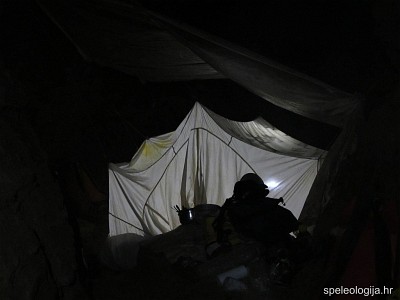
Bivouac KSS -1640 m. Photo: R.Erhardt
Provalov, Klim and Bazilej enter the cave and descend to the
bivouac Sandy Beach at -1,410 m.
November 2, 2009, Monday
Again, not enough sleep. Misha and Vasya go back to -1,480 m to fetch
the remaining bags.
Dima, Dima, Robi and I get ready for the bivouac Peremička at -1,960 m.
The two Dimas go first, while Robi and I remain in the bivouac because
my camera is not working. It refuses to operate and informs me that
there is condensed humidity. I dry the camera in the hope that it would
start working. An hour later the camera is OK so we two set off.
We soon reach The Way to the Dream passage. It really is like a dream,
in fact, more like a nightmare. Between -1,640 m and -1,700 m you enter
a narrow and low passage about 60 m long. You can pass the canal with
only one transport bag. You negotiate the passage by dragging yourself
sideways and lying in the water which soaks the inner clothing through
the sleeves and the legs of the caving suit. A unique experience! You
drag the transport bag behind you. It often gets stuck, so you must
constantly kick it into the best position, and then pull it by the rope.
Then several short vertical drops follow. The cave descends elbow-like.
Passages with potholes, speleothems and waterfalls follow one another.
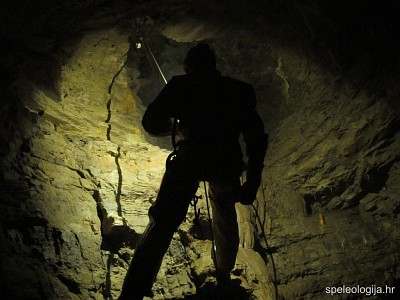
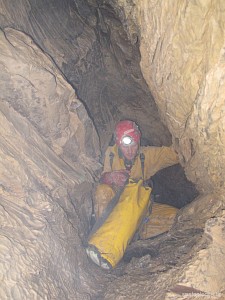
At -1700 m. Photo: R.Erhardt
We take photos. Robi is in front of me, then a second later behind
me, so we alternate in breaking the Croatian depth record: - 1,700 m, -
1,800 m, etc.
We finally reach the “Peremichka camp” (-1,960 m), where we are supposed
to spend the night. The Dimas inform us that they did not find the
sleeping bags but only the bivouac. We level the bottom of the passage,
set up the bivouac and put our heads together to solve the problem of
sleeping arrangements. It's no big deal, because we have enough
gasoline, so we can warm ourselves the whole night if necessary.
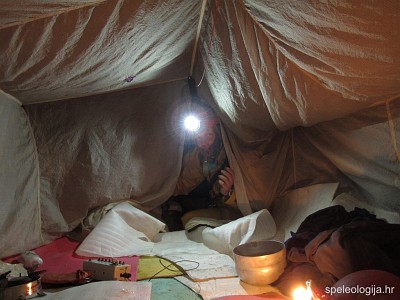
Bivouac Peremichka -1960 m. Photo: R.Erhardt
We call the team in the KSS bivouac with Misha, Vasya, Provalov,
Klim and Baziley. They think a little about our situation and make a
decision. Provalov will bring two sleeping bags to the Peremichka
bivouac and will sleep there with the Dimas, but Robi and I must go back
to the KSS bivouac. Robi and I look at each other. No problem, but first
we will go down to the bottom, to the Game Over chamber, because who
knows whether we will ever get another chance for descent.
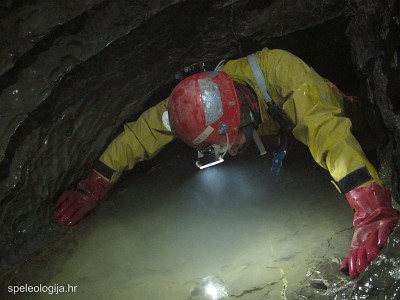
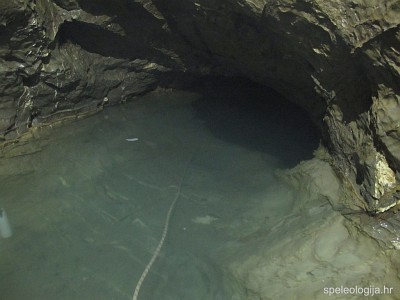
Kvitocha sump -1980 m. Photo: R.Erhardt
It will soon get very crowded in the Peremichka bivouac. It
holds only 4 people. They need to dive and widen the passage. We consult
with the Dimas. They help us wholeheartedly. Dima Vikorchuck takes us to
the Kvitocha sump, while Dima Fedotov sets up the rope to the Game Over
chamber. We hurry, take pictures of the Kvitocha sump, climb back to the
bivouac, pass the bivouac and continue into the passage that leads to
the Game Over chamber.
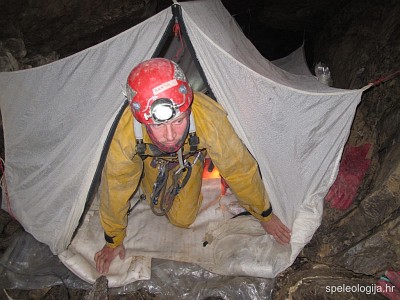
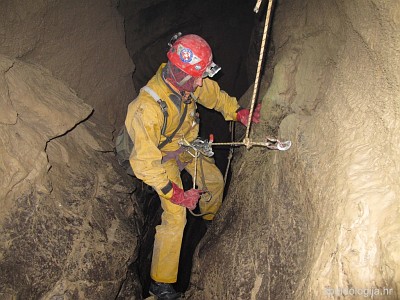
Bivouac Peremichka. Descending down to Game Over. Photo: R.Erhardt
We take pictures on the way, and finally, at 22.40 we
reach Game Over, a sandy chamber at -2,080 m. We leave the traces on the
floor which the water will soon erase, just as it has erased the traces
of all those speleologists who had descended here before us. We take
photographs with Dima. THE CROATIAN DEPTH RECORD!
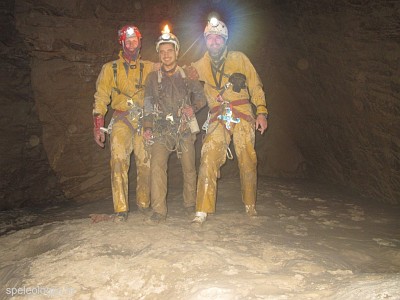
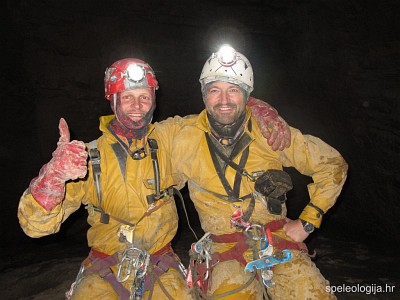
Game Over -2080 m Bakša-Dima-Robi (left). Photo: R.Erhardt.
Game Over -2080 Bakša and Robi. Photo: Dimitrij Fedotov
PURE JOY … a speleological dream come true.
We climb up and unwind the ropes to the bivouac Peremichka, where
Provalov is already waiting. He tells us off a little for not listening
to him and not heading straight for the KSS bivouac. We look at him and
laugh. He understands, he sees that we still have enough energy left,
and he laughs with us.
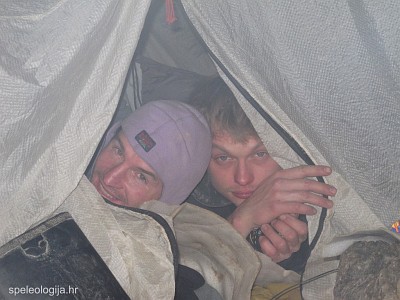
Provalov and Dima in bivouac Peremichka. Photo: R.Erhardt
It doesn't matter to us when we will reach the KSS bivouac. We
feel so great that nothing can spoil our happiness. We don't mind having
to climb the next three hours and squeezing through water. It doesn't
matter that we have not slept properly for several days. It's no big
deal that there are not enough sleeping bags at the KSS bivouac. Maybe
it is a good thing that we will arrive just before morning, since the
bags might be empty by then. We say hello to the team and, happy and
cheerful, get on our way.
November 3, 2009, Tuesday
We reached the KSS bivouac in three hours. We try to get ourselves dry
by the stoves and wake up the roommates in the process. They just
comment: "Ah, our Croatian brothers". We squeeze ourselves into their
bags. Robi into Bazil and Vasya's, and I into Klim and Misha's. Again,
we sleep badly. We manage to put in only 3 hours of sleep.
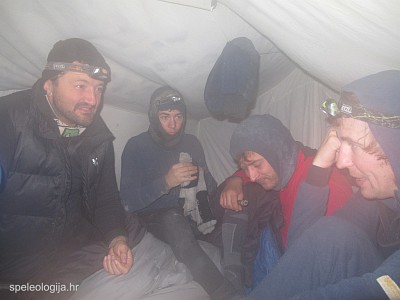
Return to bivouac KSS -1640 m. Photo: R.Erhardt
At 8 o'clock we have a telephone conversation with the surface
crew. They inform us in panic that 2 m of snow has fallen in two days
and that there was great danger of avalanches. One avalanche has already
pulled down a part of the base tent containing all the food. The small
tents are covered with the snow, and so is the entrance to the cave. A
quick change of plan: the Croatian brothers must get out urgently,
together with Provalov, in order to organize camp evacuation to a safer
place and find a way for descending the mountain. The rest of the team
goes to the Peremichka bivouac, where they follow the plan and continue
expanding the passage which would bypass the Kvitocha sump. A race
against time begins. Castling in the cave – like a chess game in which
we are the pawns in the hands of Mother Nature. But unity works miracles
and we all function like a well-oiled mechanism. The two Dimas begin
with diving into the Kvitocha siphon. Klim and Bazil join them so that
the passage can be widened from two sides. Vasya and Misha transport the
gear to -1,960 m and go back to the KSS bivouac. The Hungarians descend
from the Sandy Beach bivouac at -1,410 m to the KSS bivouac at -1,640 m,
while our job is to help them pass the siphon. At the end of the day we
are all in our allotted places, all the wheels are turning. Passing the
siphon at -1,440 m on the way back is even more unpleasant. Robi even
had to go back through the siphon once again because I did not realize
that the rope for pulling the transport bags had not been latched to
anything. We finally reached the Sandy Beach bivouac, went to get water,
tidied up the bivouac, took out the food and started cooking. Soon
afterwards, Provalov joined us in the bivouac.
We are told that it is very cold outside and that the surface crew
cannot dig out the tents from under the snow alone. What is extremely
important is that when the people come out of the cave there must be a
good shelter waiting for them; otherwise, exhausted and wet, they don't
stand a chance of surviving in the snow and the cold. What is waiting
for us up there? First, dig the way out of the cave, push through the
snow to the camp, dig out the tent, and relocate the tent to a place
that is safe from avalanches.
If we want to do all this, we must get a good rest and sleep.
November 4, 2009, Wednesday
We wake up. There is the sweet scent of success, but it's not over yet.
It may be hard and dangerous outside, or even more dangerous because of
the avalanches. We cook the tea and the various foods. Provalov,
carrying a light transporter bag, sets off first to assess the situation
on the surface as quickly as possible. The two of us go to the bivouac
at -700 m with one transport bag each. Here, we dry ourselves, fix the
gear, eat and sleep.
November 5, 2009, Thursday
We get up at 6 a.m. in order to start as soon as possible. After
breakfast we tidy up the bivouac and make it ready for the team that
follows, and set off at about 10 a.m. In the Sinusoida Meander I
overtake Robi, but the last 100 m my main light stops working, so I
continue with Tika. I get out at 2 p.m. I fight my way through the
snow-covered entrance and hear Provalov: Hey, Darka! (this is what they
call me). He had climbed up from the depth of -1,400 m in 5 hours and 45
minutes yesterday. He tried to dig through the entrance with his hands,
but could not make it. He had gone back to the depth of -60 m, taken a
metal rod, and started boring a hole in the snow. It took him two and a
half hours before he finally got out of the cave.
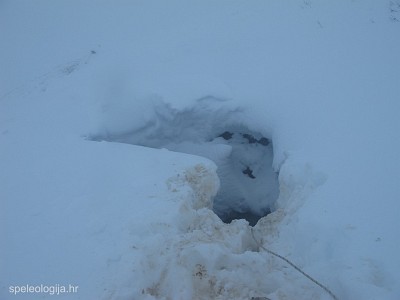
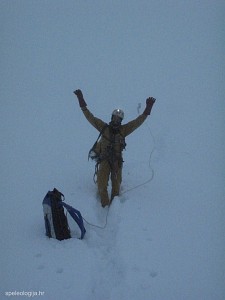
Voronya entrance after 7 days in a pit. Photo: R.Erhardt
Robi after 7 days in a pit. Photo: D.Bakšić
However, the snow was so soft that he could not walk, so he had
to crawl on his belly all the way to the camp. Today, he came to the
entrance to hoist a rope that would lead to the camp. The snow had
hardened a little in the meantime, so it was easier to get to the tent,
but I got hypothermic very quickly. Our tent is out of the snow,
welcoming me. I enter the tent and change, and Valery brings me hot tea.
I thank him and give him a beautiful stone from the cave. We are both
overjoyed. Robi arrives two hours later.
The camp is in chaos. The main tent had been pulled down by an avalanche
and it takes us hours to dig it out from under the snow. We hear the
roar of the avalanches, we see them on the neighboring mountain slopes.
It snows again in the night, so in the dark we move the tent to a safer
place.
In the cave, everything goes according to the plan. At about -2,000 m
the teams take turns to expand the passage. In the beginning, they work
from both sides, but must give up because the air between the Kvitocha
and the Podnir sumps is bad.
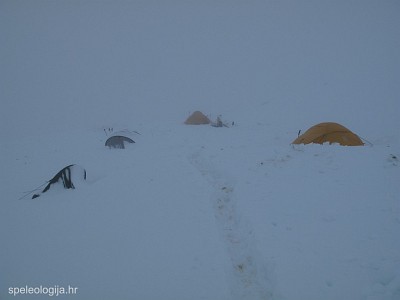
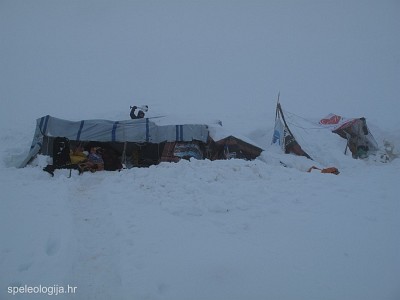
The camp is in chaos. The main tent had been pulled down by an avalanche.
Photo: D.Bakšić
November 6, 2009, Friday
It cleared up during the night and the camp is lit by the full moon. It
grew very cold. A beautiful, sunny day dawned. After breakfast we
continue with digging out the base camp and the small Hungarian tent,
which had broken down under the snow. We make a smaller kitchen from a
part of the base camp construction and transfer into it the food dug out
from under the snow. Robi manages to put the power unit into operation,
so we are able to charge the batteries of our various electronic
devices. Provalov goes to the place where we had been unloaded from the
truck. It took him over three hours to do that! We communicate with the
team in the cave twice a day. The Hungarians are climbing up from -1,410
to -700, carrying two transport bags each, while the team on the bottom
works in shifts 24 hours non-stop.
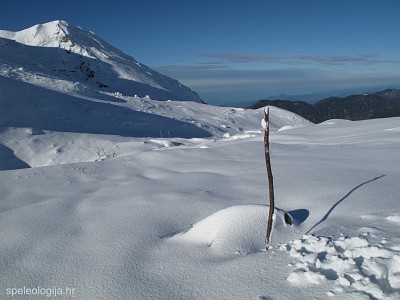 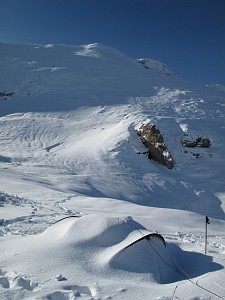
Hungarian tent, which had broken down under the snow. Photo: D.Bakšić
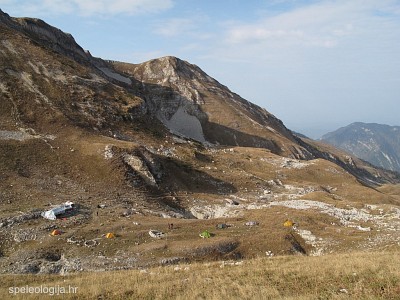
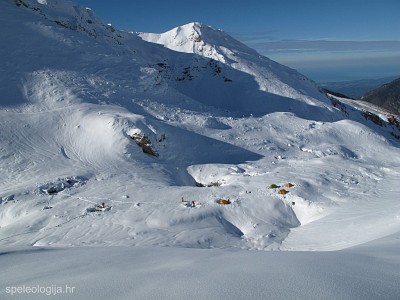
Base camp before and after snowstorm. Photo: D.Bakšić
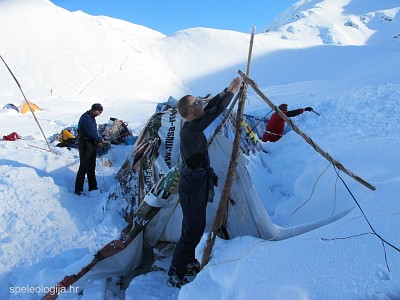
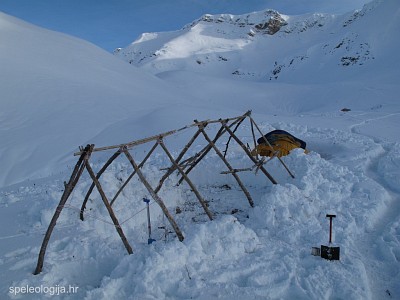
Base tent. Photo: D.Bakšić
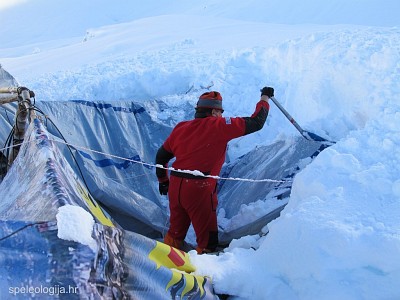 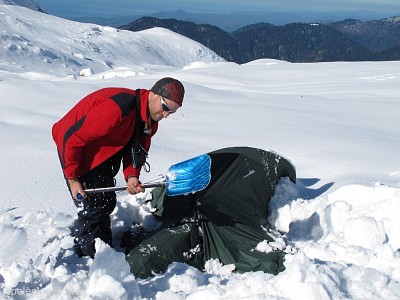
Removing the snow. Photo: R.Erhardt
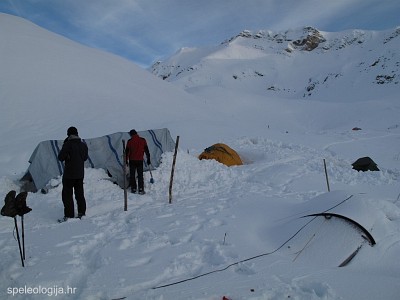
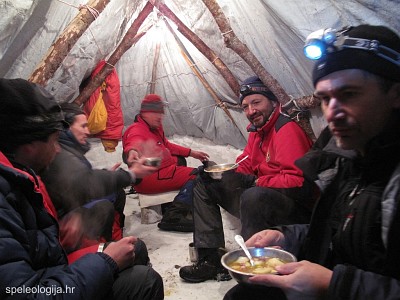
In new base tent. Photo: D.Bakšić
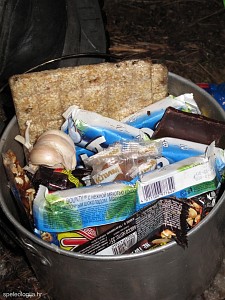 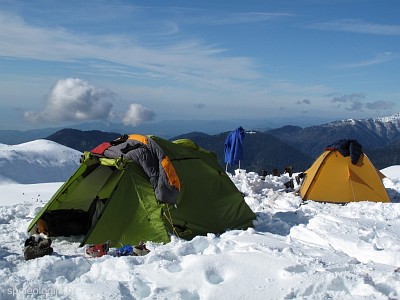
Food and drying. Photo: D.Bakšić
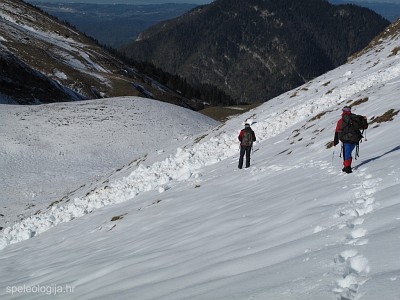 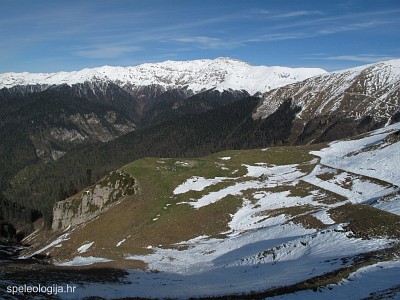
Small avalanche.
Place of Ortobalagon. Photo: D.Bakšić
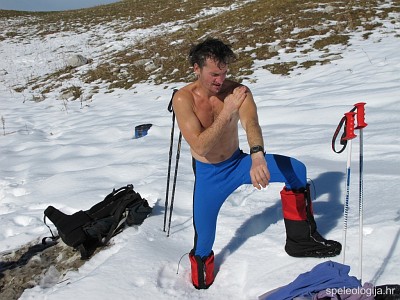 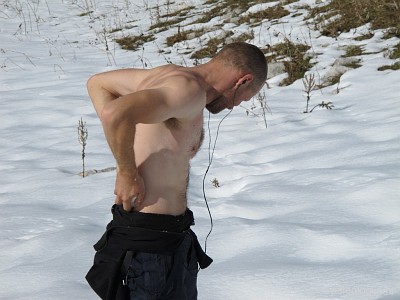
Snow washing. Photo: R.Erhardt
November 7, 2009, Saturday
Another beautiful day. The sun clears away all the strife, worries and
problems. Only good moments are incised in memory. Sunrises and sunsets
on Arabica are magnificent. Surrounded by the snow, we look down at the
sea.
Breakfast as usual. Five pieces of sausages each, two pieces of cheese
and a piece of bread. Steaming coffee or tea is a must. A smile and care
for one another. This team is really good, we feel as if we have known
each other for 100 years.
We start for the pass early to check if the truck can reach this spot.
We do not fall through the snow because it is still hard. The
surrounding slopes glitter shining white, and we are imbibed with the
beauty around us. At the loading place we rest a little and scrub
ourselves with the snow. We pass by the summer place of Ortobalagon, an
idyllic village on the edge of a canyon, where people bring their cattle
over the summer. We walk for a long time and miss the road, since the
edges are invisible under the snow. When we reach the pass, we see that
snow drifts have covered the road and that it will be impossible for the
truck to pick us up from there. Provalov immediately calls the pilot and
arranges a pick-up by a helicopter on November 12. This is the last
stable day before the weather gets worse. We must transport all the
surplus equipment stored in the barrels from the unloading place to the
camp, and then transport everything down the mountain. Each of us
carries over 20 kilograms of the equipment we don't need up to the camp.
Our feet are frozen, and we can hardly wait to get to the warm base
camp. The Hungarians welcome us in the camp. They had also been to the
Game Over and are overjoyed.
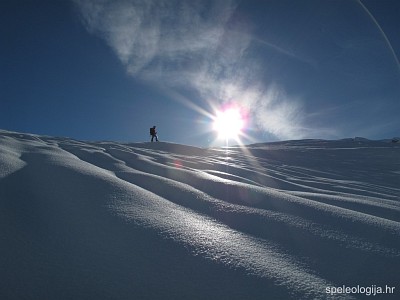
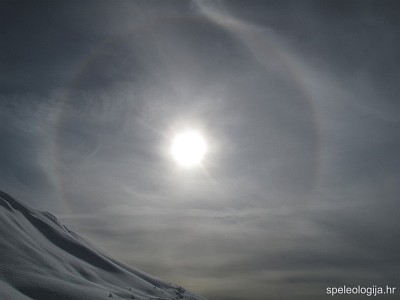
Photo: D.Bakšić
November 8, 2009, Sunday
There is no end to carrying the equipment! Now we are moving all the
gear to the place where the helicopter can land. A small ridge about
twenty minutes' walk away, steeply above the camp, is suitable and
sufficiently hard to serve as an impromptu helidrome. We leave some of
the things in the nearby Ž 13 cave; it might come handy for the next
expedition. The whole canvas of the base camp has finally been
completely dug out from under the avalanche, so we fold it and carry it
to the helidrome on the ridge.
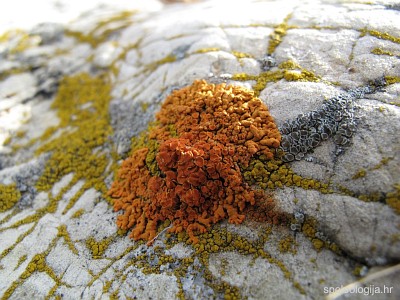
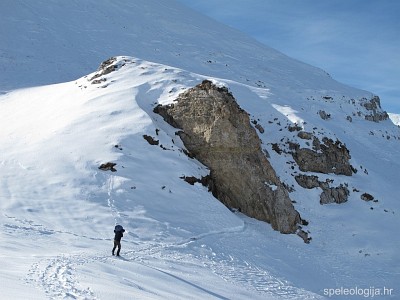
Photo: D.Bakšić.
We leave some of the things in the nearby Ž 13 cave. Photo: R.Erhardt
The team on the bottom of the cave has used up all the
batteries, but has not managed to break through. We are all a little
disappointed because we had hoped they would succeed. I can only imagine
how the guys down there must feel. But this is speleology. A lot of
toil, perseverance and team work. The next expedition picks up where the
previous one has left off.
The ascent to the surface begins. Misha and Vasya go towards the Sandy
Beach bivouac, and the Dimas, Klim and Bazil sleep their last night in
the Peremichka bivouac.
November 9, 2009, Monday
I was supposed to go to the cave with Provalov today, take the carbide
and the petroleum down to -1,410 m and help bring up the equipment.
Unfortunately, he had been vomiting the whole night and cannot leave the
tent. Three team members have already had short-lasting (one day)
problems with metabolism.
In the cave, Vasya and Misha climb from -1,401 m upwards, while the team
from the Peremichka bivouac ascends to -1,410 m.
We postpone entering the cave for tomorrow and hope that Provalov will
be better. A part of the day we carry the gear to the improvised
helidrome on the ridge, and in the afternoon we finally have a little
rest free of duties.
We listen to the weather forecast, which announces that the weather
would turn foul one day earlier than expected. Consequently, November 11
is the last day for departure and everybody must be out. Misha and Vasya
come out of the cave at about 9 p.m. Provalov telephones to say that
everybody must be out of the cave by tomorrow. If we are caught in bad
weather, we could be stuck here for days and weeks. We are all aware of
this possibility. Another race against time begins because everything
has to be ready for a helicopter flight.
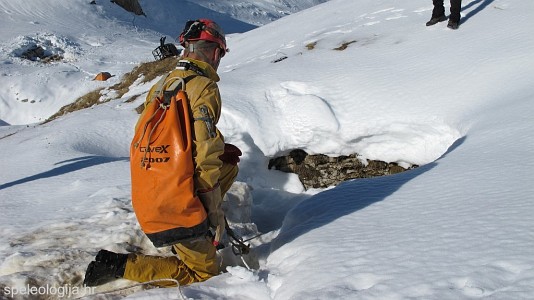
Voronya - descending to the camp at -700 m. Photo: R.Erhardt
November 10, 2009, Tuesday
Provalov wakes me up with the news from the cave. They have fixed the
bivouac at -1,410 m, dried, powdered and stored the water-proof suits
hydrocostumes. They don't have any surplus transport bags, so the two of
us only descend to the camp at -700 m to collect garbage and the
sleeping bags.
Provalov and I enter the cave at about 11 o'clock. It takes us one hour
to tidy up the bivouac and then we climb out. All together, it took us 5
hours and 50 minutes, including the tidying up the bivouac.
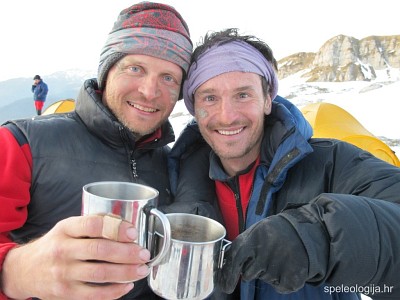
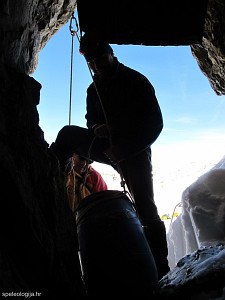
Bakša and Provalov after returning from -700 m. Cave Z 13. Photo: R.Erhardt
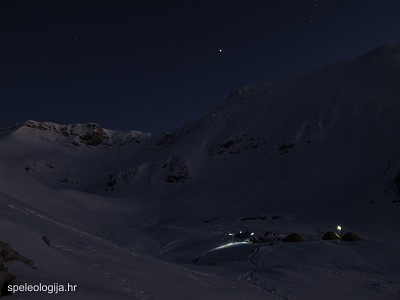 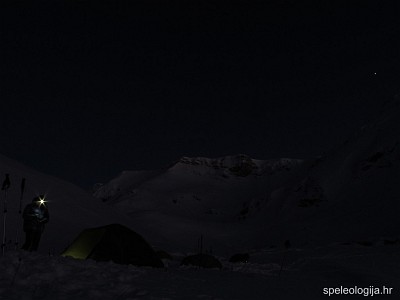
Last night in the base camp. Photo: D.Bakšić
November 11, 2009, Wednesday
During the restless night I got up several times and finally went into
the kitchen. First I waited with Misha and Vasya for the two Dimas. We
heated the borsch and the porridge for them. They told us all about
failing to complete the work of widening the passage. There are only 2-3
meters left. This means that one more action like this and the Kvitocha
sump will be bypassed. About 3 a.m. I am woken up by the voices of Klim
and Bazil, who have reached the camp. Now, everybody is out. We chat a
little and go to sleep at 4 o'clock. After one hour we wake up and carry
our things to the helidrome, since the helicopter is scheduled to pick
us up at 7.30.
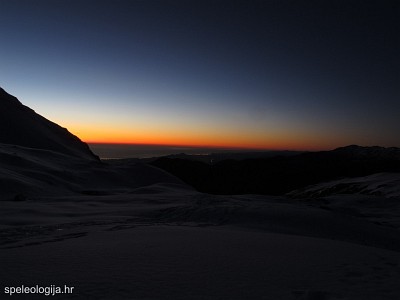 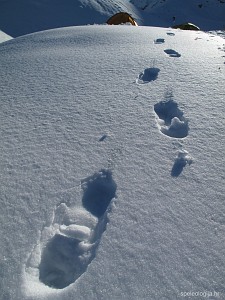
The base camp. Departure. Photo: D.Bakšić
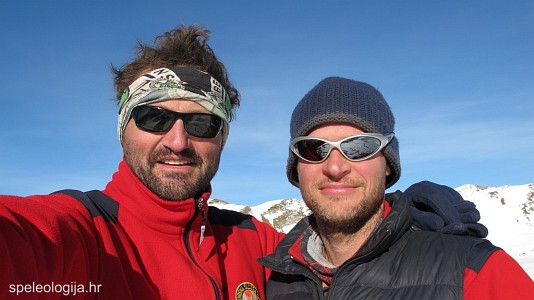
Robi and Bakša
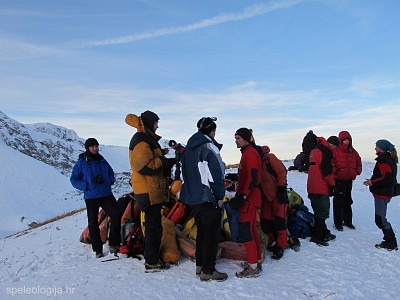 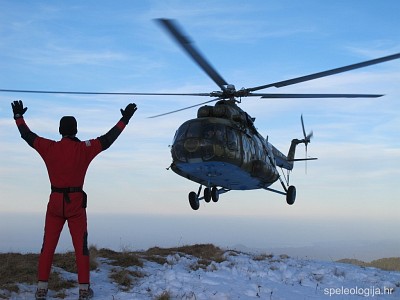
Waiting a helicopter. Photo: R.Erhardt
The pilot landed on the small area masterfully. We put in all the
equipment, climbed in and took off.
In some twenty minutes we landed on the beach in front of our house. We
got off the helicopter looking like aliens in space suits – wrapped up
in pullovers and Goretex jackets. A lot of people gather gaping at us in
wonder.
The heat makes us peel off layers and layers of clothing rapidly. We
take the gear into the house, have lunch, sunbathe on the beach and swim
in the Black Sea.
Sheer happiness after a job well done! Two weeks of incessant hard work
for the moment of rest in a circle of people tightly bound with
friendship two kilometers deep. When tomorrow comes, everybody will go
their separate ways.
We wash and dry the equipment, watch films and sip beer and wine.
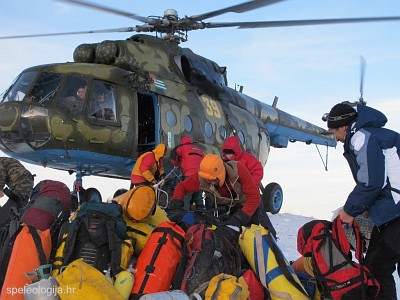 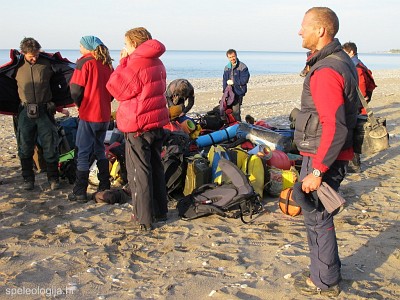
We landed on the beach. Photo: R.Erhardt
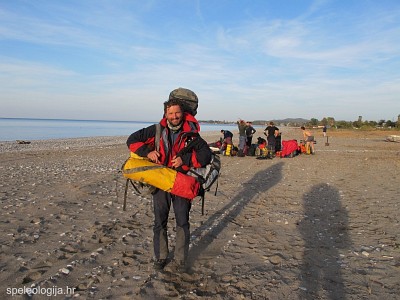 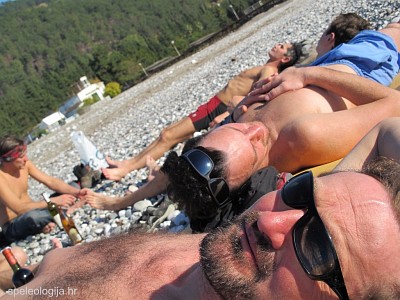
Photo: D.Bakšić.
Photo: R.Erhardt
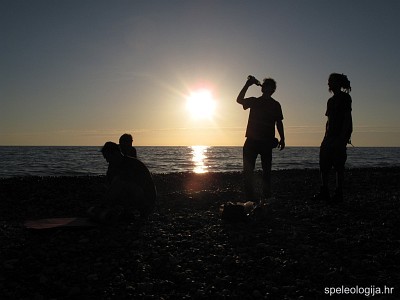
Photo: D.Bakšić
November 12, 2009, Thursday
We sort out the things, pile them into a minibus and head for the
border. Mixed with the Russians and the Ukrainians we walk out of
Abkhazia on foot. Many people cross the border by a bridge pushing
overflowing carts.
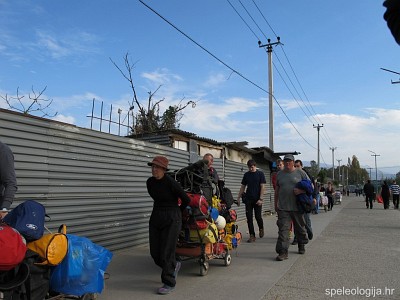
Abhazija-Russia border. Photo: R.Erhardt
We rent a van and go to the railway station, where we say
goodbye to Vasya and Dima, who go home to Samara and the Urals. The
train ride takes only three nights and two days. We say goodbye to Klim
and the Hungarians, who are taking the train for Kiev tomorrow, and go
to the airport. Our flight to Moscow is at 8 p.m. We sleep over at
Andrei's.
November 13, 2009, Friday
A sightseeing tour of the Red Square. It is enormous and beautiful.
There is The Gum nearby – a large shopping mall. Robi remembers how only
20 years ago you could not buy anything here, while now prestigious
fashion boutiques follow one another.
We also visited the museum of history and an exhibition of Russian gold.
In the evening we take the underground to the speleological club. In the
immediate vicinity is a small hall where speleological techniques are
practiced. We watch Provalov's photographs from this expedition and our
film abouth Velebita cave. On the way to Andrei's apartment we stop at
Bellevue and admire the magnificent views of the city. We say goodbye to
Provalov and Zenya, have dinner with Andrei and chat late into the
night.
November 14, 2009, Saturday
At the recommendation of the hosts, we decide to take a train to St
Petersburg. We go to the railway station "Kiev vakzal" and buy tickets
for the night train. We walk around Moscow the whole afternoon, have
dinner, pick up our stuff and wait for the train.
November 15, 2009, Sunday
We set off from Moscow at 3.40 a.m. and arrive in St Petersburg around
noon. The cavers Dima and Vanya wait for us at the station. They show us
around the city, and in the evening they take us to the hall where
speleological techniques of rope climbing are practiced and competitions
in fast rope climbing are held.
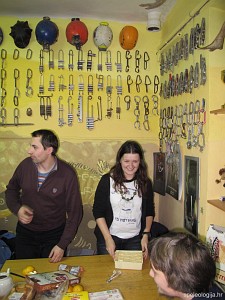
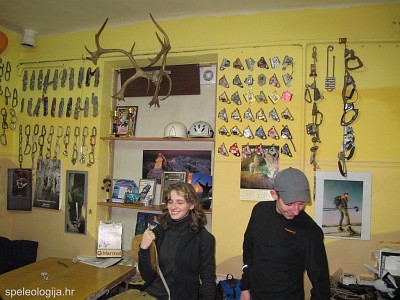
In speleological club in Moscow. Photo: R.Erhardt.
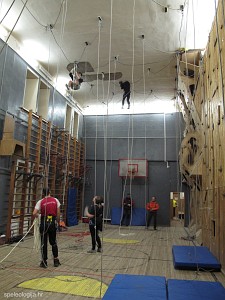
Practicing speleological techniques in hall. Photo: D.Bakšić
Practicing speleological techniques in halls and sports
competitions are common in Russia, since the closest speleological sites
are as far as 2,000 km. The level of training and motivation must
therefore be maintained. Two to three times a year they go to
speleological expeditions. In the evening Dima and Vanya leave us in
Masha's, Natasha's and Roman's hands. We sleep over at their place.
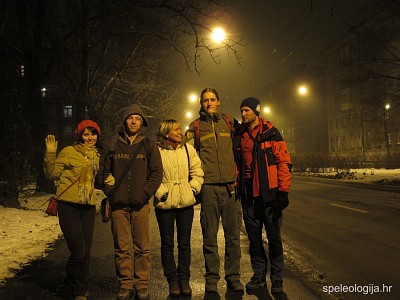
In the evening Dima and Vanya leave us in
Masha's, Natasha's and Roman's hands. Photo: D.Bakšić
November 16, 2009, Monday
The friendly cavers Natasha and Masha take us around St Petersburg
today. Masha's real name is Marija Tikka. She points out proudly that
she is an Ingermanlander, a member of a rare East Baltic people.
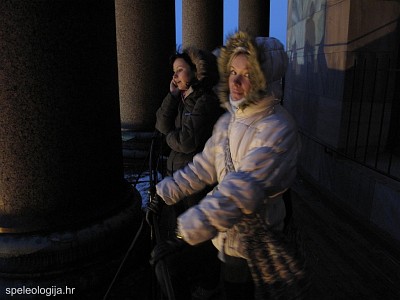
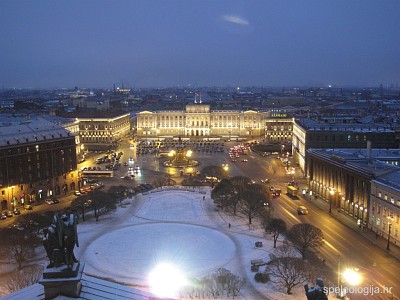
The friendly cavers Natasha and Masha take us around St Petersburg.
Photo: D.Bakšić
We look at the Winter Palace of Hermitage, unfortunately only
from the outside since the museum is not open on Mondays. We visit the
church built in honor of Czar Alexander II, and then the Russian Museum
with an exhibition of paintings from various periods.
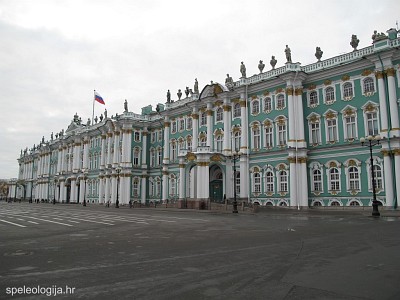
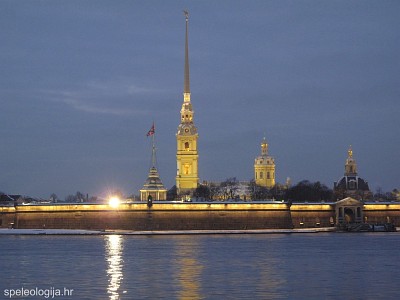
Photo: D.Bakšić
We are absolutely delighted with the cavers and the city, and
conclude that this is where we must definitely return.
We spend the evening in the company of Natasha, Masha and Roman talking
about speleology and diving, and then set off for the train to Moscow.
November 11, 2009, Tuesday
We spend the whole day at Aeroflot attempting to confirm the ticket for
tomorrow's flight to Zagreb. Since today we did not fly from Sochi as
planned, they claim that our ticket for Zagreb is invalid. To make
matters even more absurd, we are forced to buy a new return ticket as it
is cheaper than s single ticket. The unplanned 330 Euros per person and
the feeling of being cheated spoils the wonderful impressions from the
expedition and traveling around Russia.
We dine at Provalov's in the circle of his family. In the evening we get
together with Andrei and Provalov and have another dinner.
November 11, 2009, Wednesday
Provalov takes us to the airport. We already have some mutual plans for
the near future. We say goodbye and get on the plane. A few hours'
flight and there is our town beneath us and the dear people we missed
during the past weeks.
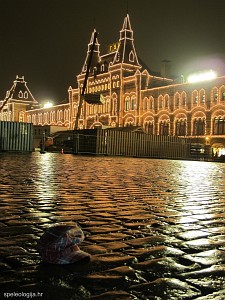
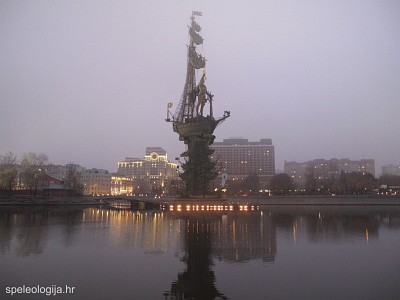
Photo: R.Erhardt.
Photo: D.Bakšić
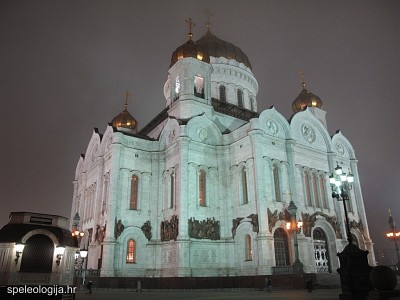
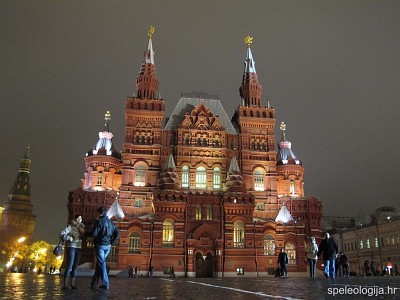
Photo: R.Erhardt
|

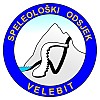
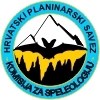



|